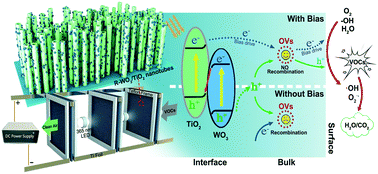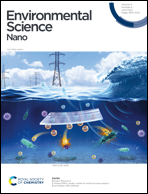Gas-phase photoelectrocatalytic oxidation of volatile organic compounds using defective WO3/TiO2 nanotubes mesh†
Abstract
The gas-phase photoelectrocatalytic (GPEC) approach has proven to be a promising one for overcoming the limitations of the conventional PEC technique for the removal of gaseous pollutants. However, the enhanced catalytic performance of this technique depends on the carrier transfer nature of the photoelectrodes employed. In this study, a defective WO3/TiO2 nanotube array mesh was developed and used as a photoelectrode in a ducted reactor to purify gaseous volatile organic compounds (VOCs). The defects were introduced by an electrochemical reduction approach, through which a significant increase in the carrier concentration and a decrease in its transfer barrier were achieved. As a result, the photogenerated electrons and holes were swiftly separated under a tiny external bias voltage. Furthermore, the bulk oxygen vacancies, generally serving as recombination centers for the carriers in a photocatalytic system, changed to charge carrier sources to facilitate the oxidation of VOCs with an external bias by weakening the trapping between holes and electrons. The ducted reactor so designed combined the advantages of both the defect strategy and the GPEC approach, which led to high performance with greater stability in the purification of gaseous VOCs.

- This article is part of the themed collection: Nanomaterials in air


 Please wait while we load your content...
Please wait while we load your content...